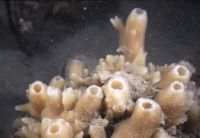Difference between revisions of "Zeetulp"
From Coastal Wiki
(→<span style="color:#00787A">Oorspronkelijke verspreiding</span>) |
|||
| Line 25: | Line 25: | ||
===<span style="color:#00787A">Oorspronkelijke verspreiding</span>=== | ===<span style="color:#00787A">Oorspronkelijke verspreiding</span>=== | ||
| − | + | De zeetulp is een kosmopoliet in warme zeeën [1]<ref name=one>Kerckhof, F. (2002). Barnacles (Cirripedia, Balanomorpha) in Belgian waters, an overview of the species and recent evolutions, with emphasis on exotic species. Bull. Kon. Belg. Inst. Natuurwet. Biologie 72(Suppl.): 93-104. [http://www.vliz.be/imis/imis.php?module=ref&refid=66768 details] </ref>. Het is niet bekend van waar deze zeepok exact afkomstig is [2]<ref name=two>Goulletquer, P.; Bachelet, G.; Sauriau, P.G.; Noel, P. (2002). Open Atlantic coast of Europe: a century of introduced species, in: Leppäkoski, E. et al. (2002). Invasive aquatic species of Europe: distribution, impacts and management. pp. 276-290. [http://www.vliz.be/imis/imis.php?module=ref&refid=40609 details]</ref>. Sommige publicaties verwijzen naar de westkust van Afrika en naar de Indo-Pacifische regio [3]<ref name=three>Wolff, W.J. (2005). Non-indigenous marine and estuarine species in the Netherlands. Zool. Meded. 79(1): 3-116. [http://www.vliz.be/imis/imis.php?module=ref&refid=101200 details] </ref>. Dit diertje is een typische aangroeisoort op harde oppervlakken [4]<ref name=four>Kerckhof, F.; Cattrijsse, A. (2001). Exotic Cirripedia (Balanomorpha) from buoys off the Belgian coast. Senckenb. Marit. 31(2): 245-254. [http://www.vliz.be/imis/imis.php?module=ref&refid=25318 details] </ref> en komt vooral voor in het sublittoraal - dit is de zone net onder de laagwaterlijn [5]<ref name=five>Fernando, S.A. (1999). Reproductive biology of tropical barnacles, in: Thompson, M.-F.; Nagabhushanam, R. (1999). Barnacles: the biofoulers. pp. 51-67. [http://www.vliz.be/imis/imis.php?module=ref&refid=35437 details] </ref>. Heel soms vind je deze zeepok ook in de lage intergetijdenzone [6]<ref name=six>NIMPIS (2002).'' Megabalanus tintinnabulum'' additional information. National Introduced Marine Pest Information System (Eds: Hewitt C.L., Martin R.B., Sliwa C., McEnnulty, F.R., Murphy, N.E., Jones T. & Cooper, S.). [http://www.marinepests.gov.au/nimpis](24/06/2010)</ref>. | |
| − | |||
<P> | <P> | ||
<BR> | <BR> | ||
Revision as of 14:07, 23 September 2011

|
|
Zeetulp
De zeetulp Megabalanus tintinnabulum - een zeepok - kwam oorspronkelijk alleen voor in tropische wateren. De exacte plaats van herkomst is niet bekend, hoewel sommigen verwijzen naar de westkust van Afrika en de Indo-Pacifische regio. De soort werd in Nederland al in 1764 waargenomen op scheepsrompen. Langsheen de Belgische kust werden in 1998 populaties van deze exoot op boeien ontdekt. De zeetulp behoort tot de vaste aangroeigemeenschap van scheepsrompen en andere harde oppervlakken. Deze zeepok treedt, wegens haar grootte, in competitie met inheemse zeepokken.
|
Contents
- 1 Wetenschappelijke naam
- 2 Oorspronkelijke verspreiding
- 3 Eerste waarneming in België
- 4 Verspreiding in België
- 5 Verspreiding in onze buurlanden
- 6 Wijze van introductie
- 7 Redenen waarom deze soort zo succesrijk is in onze contreien
- 8 Factoren die de verspreiding beïnvloeden
- 9 Effecten of potentiële effecten en maatregelen
- 10 Specifieke kenmerken
- 11 Weetjes
- 12 Geraadpleegde bronnen
Wetenschappelijke naam
Megabalanus tintinnabulum (Linnaeus, 1758)
Oorspronkelijke verspreiding
De zeetulp is een kosmopoliet in warme zeeën [1][1]. Het is niet bekend van waar deze zeepok exact afkomstig is [2][2]. Sommige publicaties verwijzen naar de westkust van Afrika en naar de Indo-Pacifische regio [3][3]. Dit diertje is een typische aangroeisoort op harde oppervlakken [4][4] en komt vooral voor in het sublittoraal - dit is de zone net onder de laagwaterlijn [5][5]. Heel soms vind je deze zeepok ook in de lage intergetijdenzone [6][6].
Eerste waarneming in België
TEKST
Verspreiding in België
TEKST
Verspreiding in onze buurlanden
TEKST
Wijze van introductie
TEKST
Redenen waarom deze soort zo succesrijk is in onze contreien
TEKST
Factoren die de verspreiding beïnvloeden
TEKST
Effecten of potentiële effecten en maatregelen
TEKST
Specifieke kenmerken
TEKST
Weetjes
TITEL
TEKST
Geraadpleegde bronnen
- ↑ Kerckhof, F. (2002). Barnacles (Cirripedia, Balanomorpha) in Belgian waters, an overview of the species and recent evolutions, with emphasis on exotic species. Bull. Kon. Belg. Inst. Natuurwet. Biologie 72(Suppl.): 93-104. details
- ↑ Goulletquer, P.; Bachelet, G.; Sauriau, P.G.; Noel, P. (2002). Open Atlantic coast of Europe: a century of introduced species, in: Leppäkoski, E. et al. (2002). Invasive aquatic species of Europe: distribution, impacts and management. pp. 276-290. details
- ↑ Wolff, W.J. (2005). Non-indigenous marine and estuarine species in the Netherlands. Zool. Meded. 79(1): 3-116. details
- ↑ Kerckhof, F.; Cattrijsse, A. (2001). Exotic Cirripedia (Balanomorpha) from buoys off the Belgian coast. Senckenb. Marit. 31(2): 245-254. details
- ↑ Fernando, S.A. (1999). Reproductive biology of tropical barnacles, in: Thompson, M.-F.; Nagabhushanam, R. (1999). Barnacles: the biofoulers. pp. 51-67. details
- ↑ NIMPIS (2002). Megabalanus tintinnabulum additional information. National Introduced Marine Pest Information System (Eds: Hewitt C.L., Martin R.B., Sliwa C., McEnnulty, F.R., Murphy, N.E., Jones T. & Cooper, S.). [1](24/06/2010)
